More and more people and companies understand the importance of preserving our planet and using green technology for ecommerce. Sustainable practices and participation in eco-friendly and ethical production initiatives become common among prominent businesses.
Regarding these values, ecommerce companies shift toward more eco-friendly practices in producing and selling goods. They promote sustainable and ethical brands, use energy-efficient operations, and cooperate with carbon-neutral shipment providers.
In this article, our experts discuss how to build an online marketplace for eco-friendly and sustainable goods. We reveal the key features, development process, and monetization opportunities, along with prominent examples. Read on to learn more about how to combine business success and sustainability with eco-friendly marketplace development.
The rise of sustainable ecommerce
The undeniable convenience of ecommerce brings also consequences for the environment. It is projected that carbon emissions due to logistics footprint in ecommerce will hit around 25 million CO2 metric tons by 2030.
The good news is that customers care about the environmental impact of their purchases. According to a PwC survey, 85% of customers admit that they experience the disruptive impact of climate change in their daily lives. Also, people are willing to pay 9.7% more on average for sustainable products, even regarding inflation and the rise in grocery spending.
This willingness is proved by McKinsey and NielsenIQ. In their consumer research, they revealed that products labeled as part of ESG (environmental, social, and governance) initiatives saw a 28% growth over five years. Products without such labels grew by 20%.
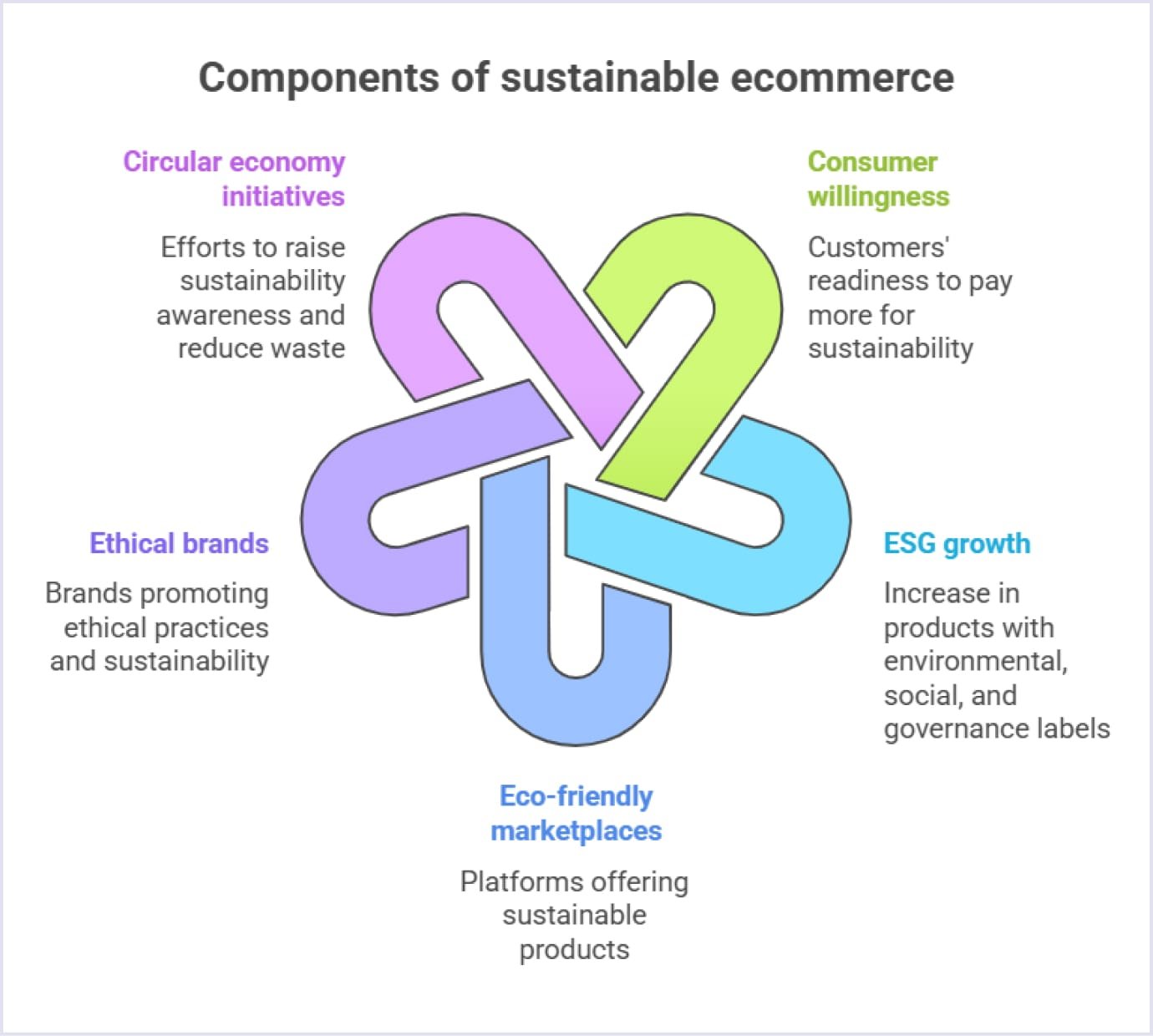
Sustainable ecommerce platforms offer different ranges of products that help to reduce waste and resource consumption in ecommerce. The most widespread are self-care, clothing, home products, hand-made items, and refurbished tech.
Many such marketplaces also support broader missions along with reducing the environmental impact of online shopping. They promote ethical brands that care about the planet, use energy-efficient technologies and fair labor in production, and cooperate with communities and circular economy initiatives to raise sustainability awareness.
Key features of a successful sustainable marketplace
Well-thought-out features outline your sustainable platform’s value to your customers. Check out the list below to learn the core features your eco-friendly marketplace needs to be a convenient and delightful solution.
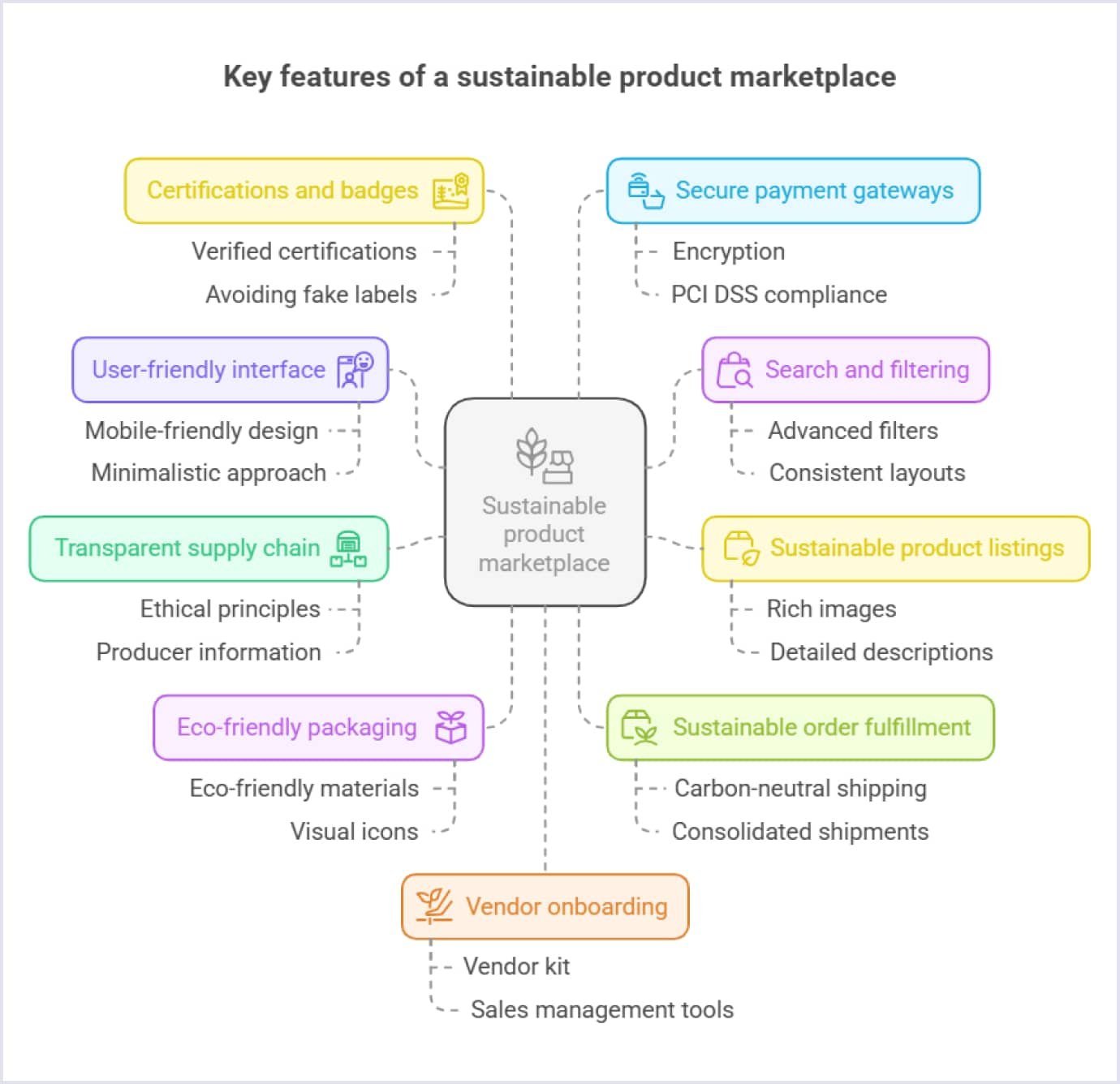
User-friendly interface and experience
A helpful and appealing design serves the main eco-friendly marketplace purposes: engaging customers and helping them find what they want. The ethical marketplace UI/UX should be mobile-friendly and responsive, and your brand mission should be outlined in clear messages.
Typically, eco-friendly marketplaces translate the message of mindful shopping via a minimalistic approach to design. The home pages and product pages are clear and easy to navigate. Such marketplaces often highlight their relation to environmental protection with greenish hues.
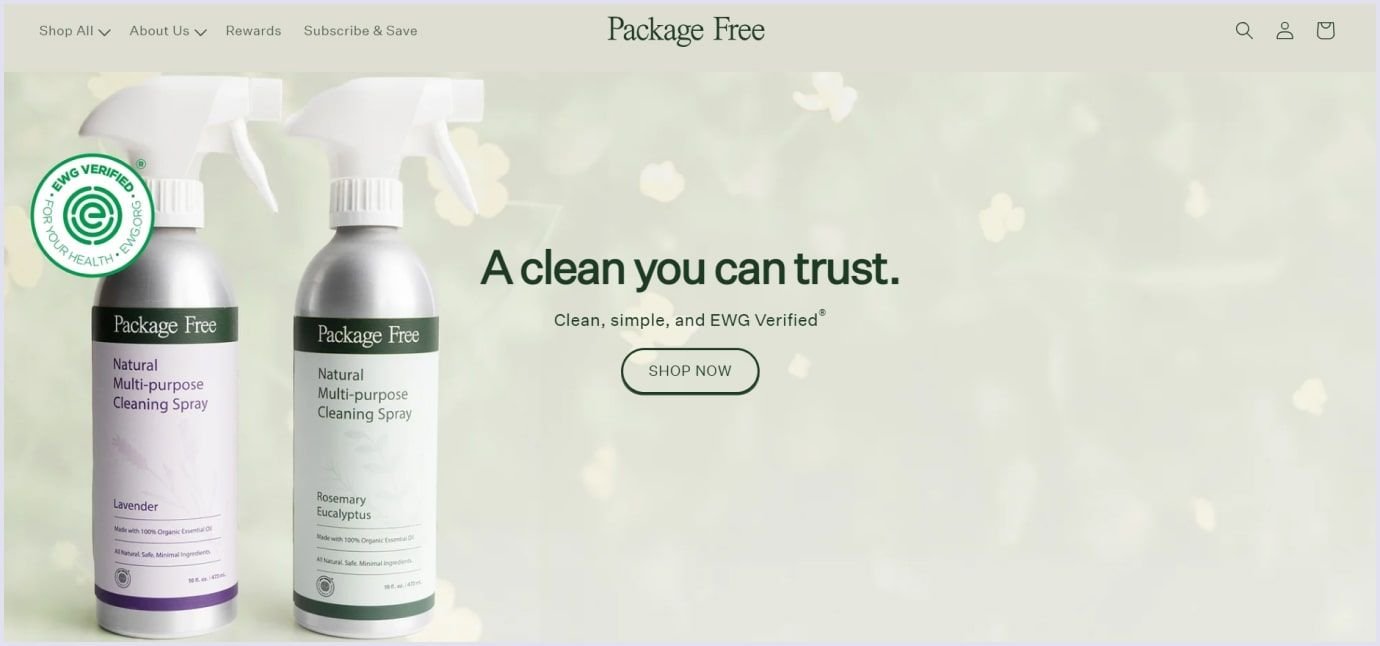
Source: Package Free
Robust search and filtering capabilities
An intuitive and smart search across your product categories helps your buyers navigate your catalog and check out the options they did not know about. Consider using the following features for search and filtering:
- Organize products with meaningful categories. Join products into groups that will facilitate product search by purposes like Gifts, Jewelry, and Accessories or by values such as Recycled Materials, Eco-Friendly Home, or Sustainable Fashion.
- Create advanced search and filters. Include advanced filters for products with specific certifications (e.g., Fair Trade, Organic), material types, or carbon footprint ratings.
- Use consistent layouts. Ensure menus, buttons, and links are easy to locate across all pages.
For example, Upcycleluxe highlights sustainable practices in product categories, such as Upcycled, Vegan, Ethical, Zero Waste, and more.
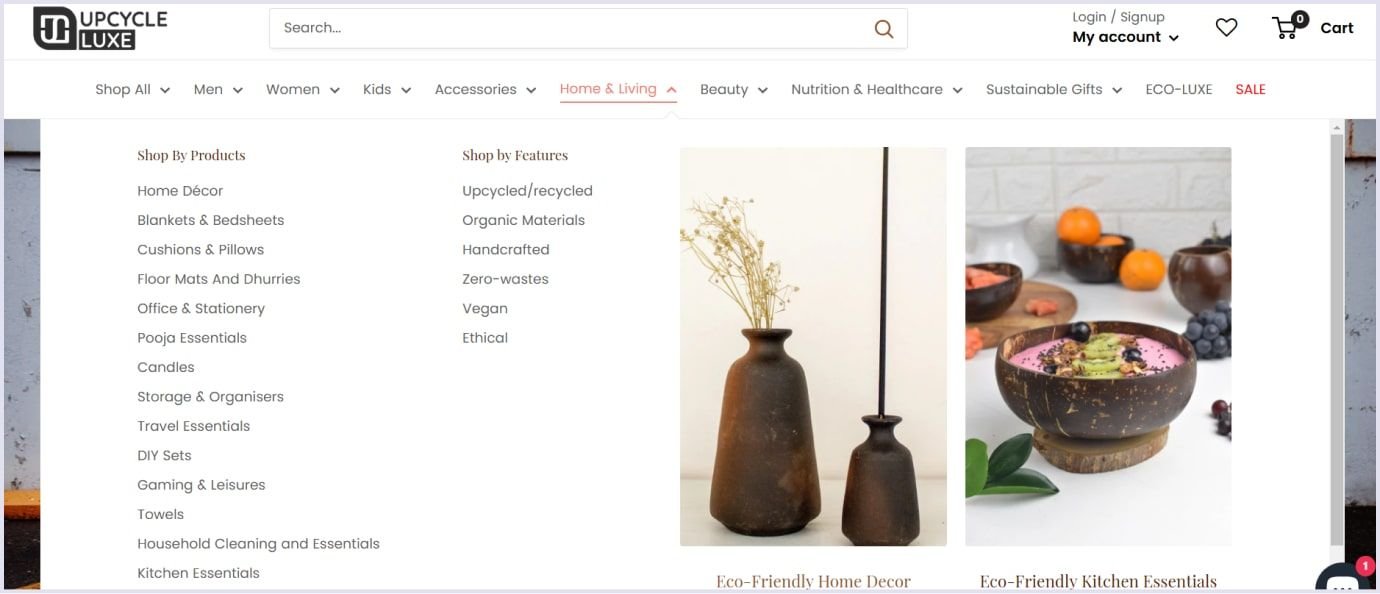
Source: Upcycleluxe
Sustainable product listings
When outlining sustainable products, rich images and detailed product descriptions help you highlight their value to buyers. Ethical marketplace solutions include purposes or sustainability themes for product listings.
Product pages also include transparent pricing and shipping costs, as well as options to add the product to a wishlist or shopping cart. Moreover, product descriptions also outline certifications and sustainable delivery practices. So buyers can understand that the marketplace works in line with their eco-friendly values.
Transparent supply chain information
Ethical marketplaces provide information on sustainable supply chain management. This helps build connections with their audiences and trust in the marketplace’s adherence to sustainable principles. Here is how you can showcase your supply chain:
- Mention ethical principles in product listings, like the product’s origin, materials, and ways of manufacturing;
- Include information about producers and sellers, like location, certifications, and working conditions;
- Describe the logistics and shipping methods used, including efforts to minimize carbon emissions (e.g., carbon-neutral shipping).
This information can be displayed on product, checkout, and order confirmation pages. For example, Ivalo, a sustainable fashion marketplace, includes tips on minimizing returns and highlights its sustainability verification process in product descriptions.
Eco-friendly packaging options
In addition to positive environmental impact, using eco-friendly packaging in ecommerce brings customer loyalty and an 8-16% increase in revenue. That is why it is helpful to encourage the use of eco-friendly packaging as one of the green marketplace trends.
To do this, add to product and checkout pages information on eco-friendly packaging used in your marketplace. These can be descriptions of your packaging practices and visual icons highlighting the approach. Delivery tracking pages on your marketplace can also hold helpful reminders of eco-friendly packaging.
Sustainable order fulfillment and carbon-neutral shipping methods
For order fulfillment, implement convenient dashboards for vendors so that they can manage their inventory and prevent unnecessary replenishments. Moreover, aim to consolidate shipments and minimize returns to improve the environmental impact of ecommerce.
As for shipping methods, support delivery services that offer carbon-neutral or electric-powered shipping solutions. For example, EcoCart is an online marketplace that provides merchants with an all-in-one sale management solution and promotes sustainable initiatives. In particular, it supports carbon offset programs and partners with ShipBob for eco-friendly shipping.
When done properly, carbon-neutral shipping practices reduce carbon emissions to zero. That is why including these practices in your marketplace will highlight your commitment to sustainability to your customers. Here are tips on where you can implement this shipping approach:
- Product and checkout pages. Add icons and descriptions of how carbon emissions are offset during shipping;
- Order confirmation emails. Explain that the order is carbon-neutral and how it impacts the environment;
- Your marketplace home page. Share stats on your carbon offset impact on your website.
Certifications and badges for verified eco-friendly products
Icons that signify your sustainable products and practices build trust and encourage loyalty to your online platform for eco-conscious consumers. That is why certifications and badges are an essential element of your marketplace website.
Genuine certifications belong to reputable organizations that have rigorous processes for verifying whether the business is truly sustainable and eco-friendly. These include B Corp, Rainforest Alliance, Fairtrade, Forest Stewardship Council (FSC), and other certifications. Check out the full list of eco-labels you can highlight on your marketplace.
Below is an example of presenting sustainability certifications in a marketplace.
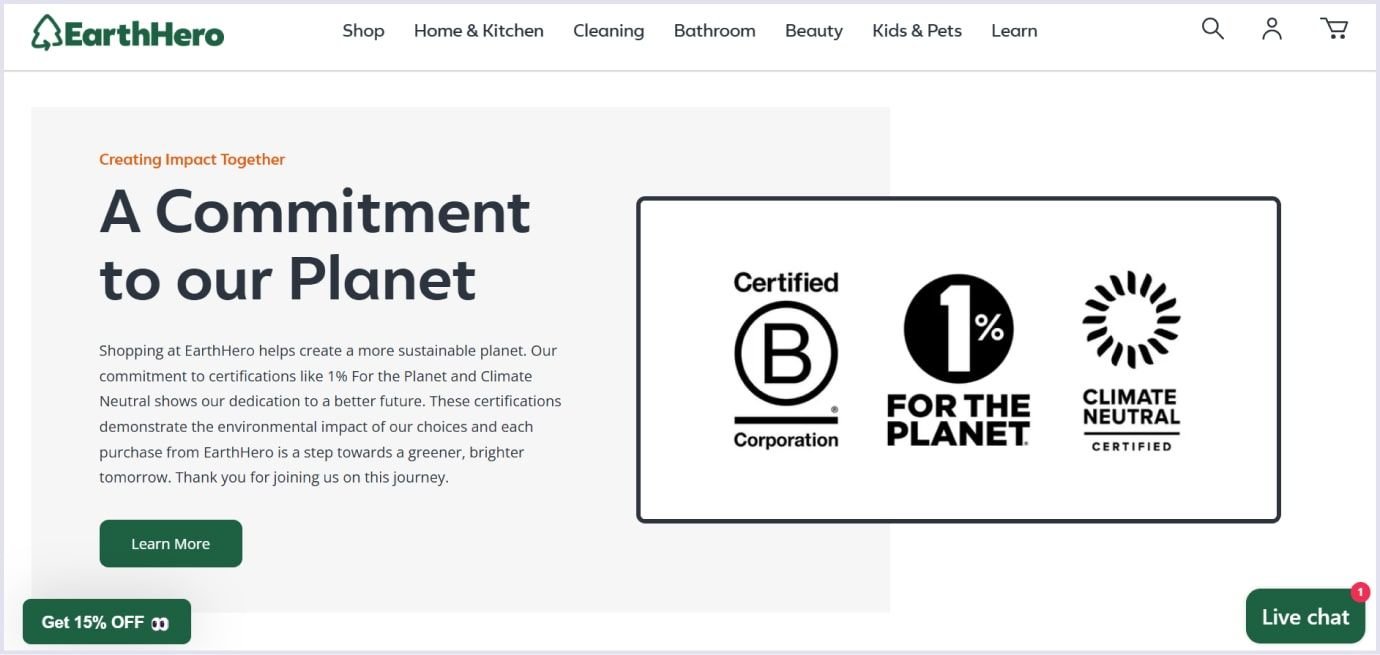
Source: EarthHero
But beware of fake certifications. Because real certifications are hard to come by, there are plenty of look-alike badges. How can you spot them? The main characteristic is that they are generic. They use titles like Eco-Friendly, Earth-Friendly, Ocean-Friendly, and other similar namings. Such labels mislead customers who prefer sustainable products and services and damage the marketplace’s reputation.
Secure payment gateways
Payment systems should support encryption and be PCI DSS compliant to ensure safe transactions. In this connection, order fulfillment should also allow for tracking, cancellations, and refunds to provide convenience to your buyers and sellers.
Regarding the mission of ethical marketplaces, payment and order management practices should also support eco-friendly approaches. So, you can integrate payment solutions that are not only efficient and secure but also support sustainable practices.
For example, Stripe Climate supports technologies that reduce carbon emissions. Businesses can strengthen this initiative by contributing a fraction of their revenue. PayPal is also committed to protecting the environment and partnering with organizations that are working to build a sustainable future.
Strong vendor onboarding and management system
When it comes to multi-vendor marketplace development, supporting your sellers with comprehensive onboarding and a sales management system is essential for your and their benefits. To get started, prepare a welcoming vendor kit that helps sellers understand platform policies, best practices for listing eco-friendly products, and tips for using sustainable packaging and logistics.
Also, the vendor dashboard in a circular economy marketplace should provide tools to upload products, manage listings, and track sales performance. Consider adding helpful resources for vendors, such as help pages, FAQs, and live support via different channels. Take vendor feedback on support into account and keep the help resources updated.
Recognizing sellers’ accomplishments is also vital, as it helps engage them with your platform. So, you can offer special badges for sellers’ achievements in sales and sustainability practices.

The sustainable marketplace development process
Implementing marketplace features is a strategic process where each stage builds upon the previous one. Let’s see what aspects you need to consider to move from your idea to implementation in online marketplace development.
Discovery phase
Before you start developing a marketplace for sustainable products, consider the details of your idea and project. At Codica, we start the development process with product discovery sessions. They help us understand your business goals, target audience, competitors, budget, and timeline. Based on these discussions, we plan the development and optimize it to meet your expectations.
As a result, you get the following deliverables:
- Clickable prototypes based on user research and your product vision;
- Cost and time estimates;
- List of priority features;
- Recommendations on team composition;
- Technical stack and architecture;
- Product specification.
Watch the video from our team on the parties engaged in the product discovery sessions.
Read also: What is Project Discovery Phase in Custom Software Development
UI/UX design
When we are all set up with the project, the next stage is design. In our UI/UX design services, we align the product vision in prototypes, refine them, and add styles to elements. As the prototypes outline the general vision, the details and possible adjustments are added at the design stage.
When it comes to designing ethical marketplaces, use a minimalist approach and enrich it with vivid descriptions and titles. The product categories can be organized around sustainability concepts, such as upcycled, plastic-free, zero-waste, cruelty-free, and more.
The main colors eco-friendly marketplaces use are a palette of green and brown hues. Your design can also incorporate nature images or icons to reinforce the marketplace’s message.
Also, if your sellers or your marketplace have certifications, badges, and achievements in sustainability, highlight them on your home page or with relevant products. For example, ZeroWasteStore marketplace highlights its accomplishments in saving the planet from excessive waste.
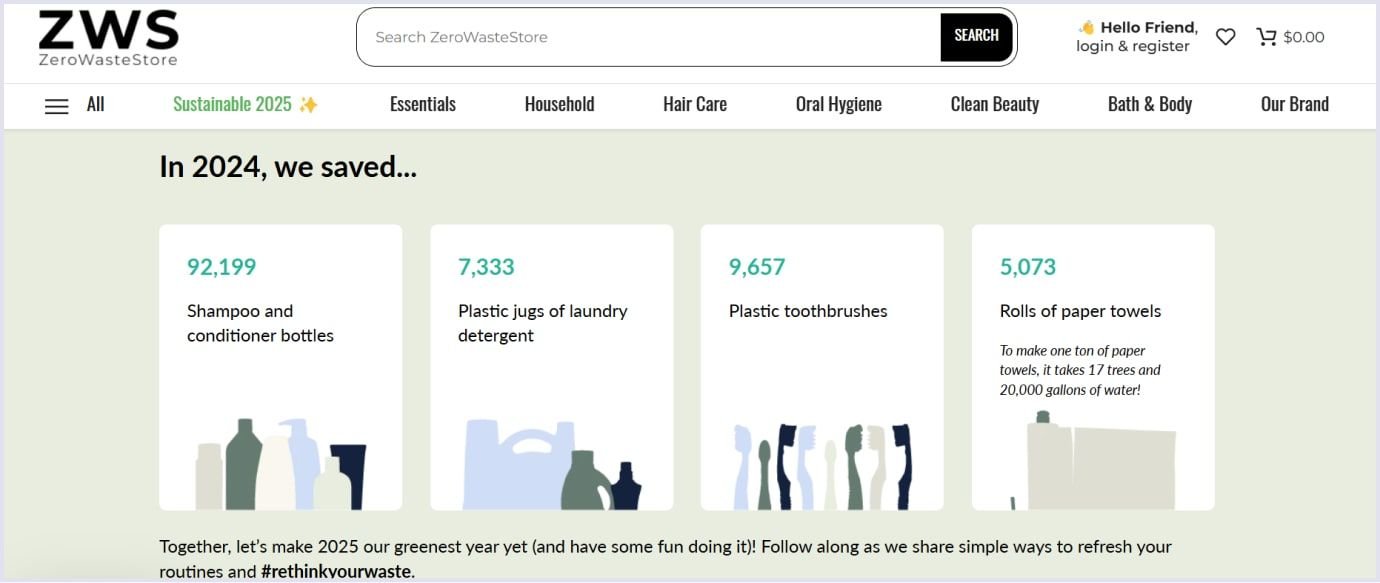
Source: ZeroWasteStore
Choosing the right software architecture
When it comes to your marketplace architecture, we recommend building it based on the MACH principle. This abbreviation stands for microservices, API-first, cloud-native, and headless. Let’s break down each of these aspects:
- Microservices. These constitute your marketplace’s business logic and backend processes that help your marketplace run;
- API-first. This software helps you retrieve data from other services and platforms and deliver them to your marketplace;
- Cloud-native. Your MACH marketplace is hosted in the cloud and scales as needed;
- Headless. It’s about your frontend. As it is decoupled from your backend, it gets flexibility in updates and becomes consistent across different digital touchpoints.
The basic principle is that MACH makes your marketplace a collection of independent elements. So, if one of them needs updates or fails, the whole system continues to work.
We use MACH in our development practices since it provides flexibility, which is vital in the modern tech-driven market.
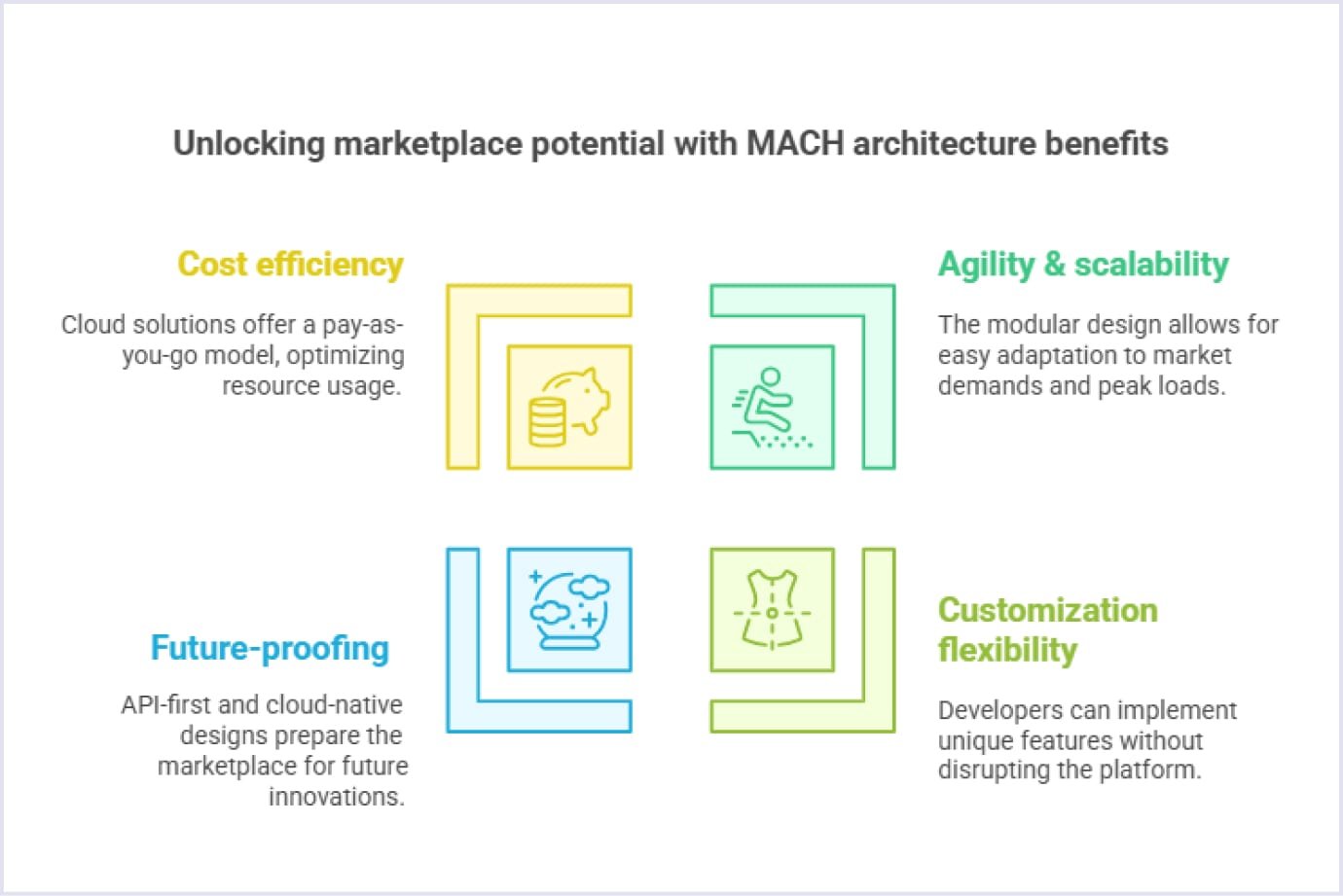
Read also: Securing Marketplaces with MACH: Best Practices and Strategies
Technology stack selection
The right tech stack for building your marketplace ensures optimization and high performance. That is especially important for eco-friendly product marketplaces. Modern technologies support the creation of green marketplace software and help optimize development processes for reasonable resource consumption.
That is why we recommend you stick with web development technologies that help you build robust and eco-friendly solutions.
At Codica, we use TypeScript and React for the frontend, Ruby and Ruby on Rails for the backend, PostgreSQL for database management, and AWS for hosting.
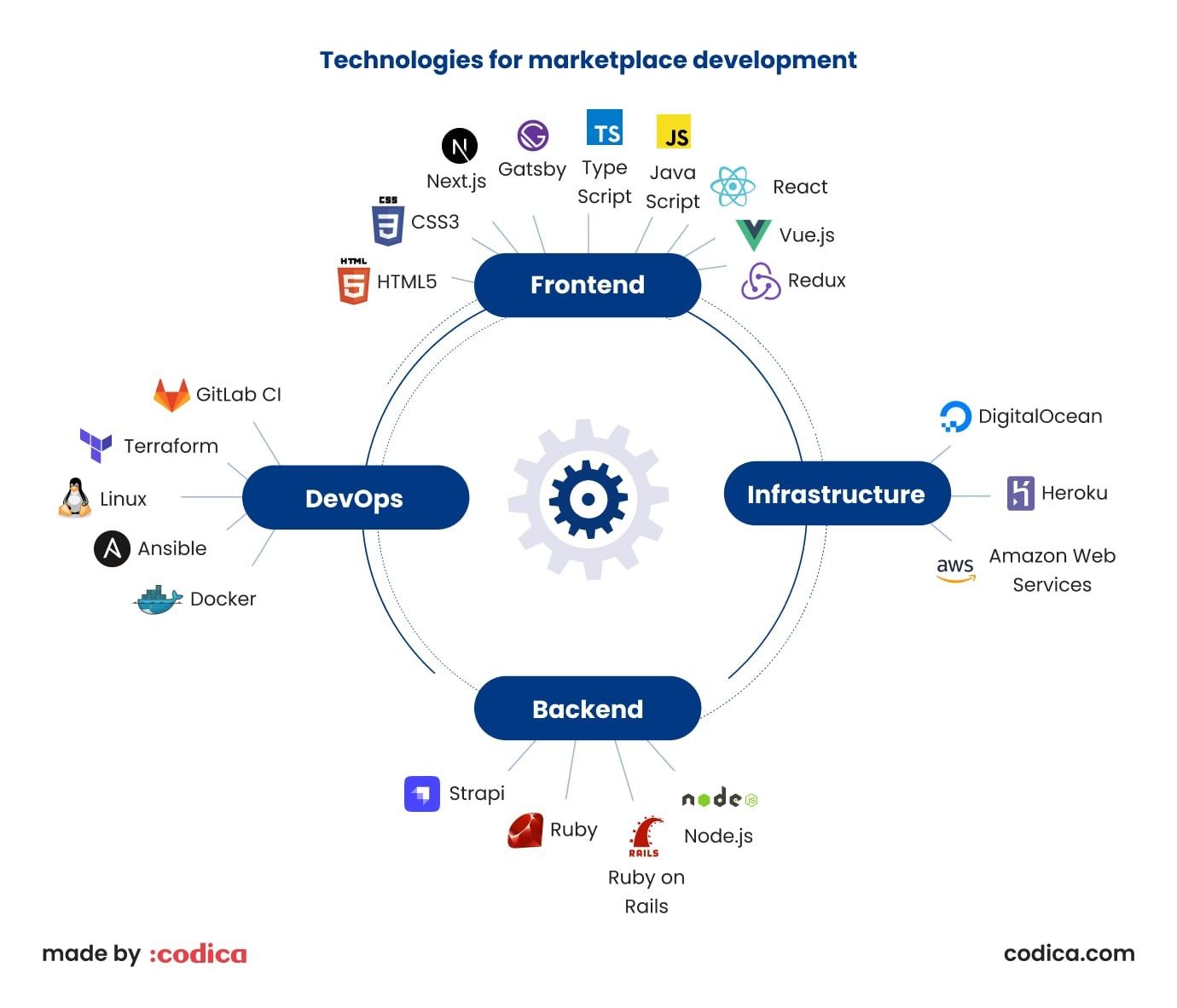
Development
This stage involves several teams that coordinate their work to craft your eco-friendly platform. The best practice for managing the project is agile. It is a time-tested approach that helps you achieve the best results with flexible management of custom web product development.
In our development process, we use DevOps services. They help us create a safe infrastructure for building and deploying the solution. DevOps engineers optimize processes and keep an eye on alerts that should be taken for improvements and optimization.
We align the client’s and our team’s vision of the project details at every step of the development process. Such coordination ensures that adjustments and changes are made as needed for the timely delivery of the solution.
We recommend starting your marketplace with MVP development services. So, you can launch your marketplace swiftly and gather valuable user feedback with minimal investment.
Testing
The ethical consumerism marketplace wouldn’t be ready without rigorous testing. It is a good practice to develop separate modules of a solution and test it along the way. After that, you need to finalize your solution with tests as a whole.
For the best results, the QA testing services involve the following tests:
- Unit testing to test the marketplace components;
- Integration testing to align connections between different components;
- Smoke testing to test the core functionalities and features;
- Regression testing to check the work of new code with the existing infrastructure;
- Acceptance testing ensures that the solution works properly and is ready to be deployed.
Thanks to these practices of automated testing, you ensure the proper work of your eco-friendly product marketplace.
Maintenance and support
Once your eco-friendly marketplace is launched, it needs timely updates and protection against security vulnerabilities. Here is what marketplace maintenance covers:
- Ongoing monitoring and timely updates based on customer feedback and business goals;
- Integrating new functionality and improving the existing one;
- Website redesign services as the marketplace grows;
- Continuous security support.

Monetization strategies for your sustainable marketplace
To help your marketplace run and evolve, the right monetization strategies should be used. Below, we cover the most common practices that monetize marketplace services and help in building a sustainable ecommerce business.
Affiliate programs
This revenue growth approach is a win-win for marketplaces and sellers. Affiliate commissions encourage vendors to drive sales. So, marketplaces get a higher turnover, sellers earn money, and customers get the eco-friendly products they want.
This approach is widespread among sustainable marketplaces. The following are examples of marketplaces and what they offer to their affiliates:
- Urbankissed gives a 10% commission on all sales an affiliate generates. Plus, they incentivize affiliates with a bonus of $175 for $2500 in net sales in the first 75 days after joining their program;
- ZeroWasteStore offers their affiliates 10%+ commission on net sales.
Transaction and listing fees
This is a common monetization strategy for marketplaces. The platform charges a fixed amount per transaction. Also, the marketplace can collect fees for all or featured listings.
For example, Etsy charges transaction fees of 6.5% per sale and $0.20 for featured listings.
Subscription fees
Subscription memberships are typically provided in exchange for incentives, such as access to exclusive offers, sales, discounts, and more. Here are examples of marketplaces that use subscriptions:
- Thrive Market’s membership is $59.95 annually and $9.95 - $12 monthly. The membership allows you to get up to 30% off on suggested prices and access to exclusive sales, discounts, gifts, and more.
- Bite offers subscriptions of $32 per 4 months as a discount for sending a package of their eco-friendly products.
Best practices for retaining customers on your marketplace
When you have attracted sellers and buyers to your platform, keeping them engaged will ensure that your platform evolves. The following are the best practices to encourage customers to stay with your marketplace:
- Loyalty programs and rewards. These include offering discounts, exclusive deals, or points-based systems rewards to customers for their ongoing commitment. They also help in building a community of eco-conscious shoppers.
- Personalized recommendations and offers. Thanks to personalization techniques, you can highlight products to customers and help them make the best choices based on their interactions with your marketplace.
- Exclusive content and community access. This could include early access to new products, members-only events, or specialized forums.
- Exceptional customer support. Comprehensive and easily reachable help ensures that your customers receive timely answers to their needs.
- Regular communication and updates. Providing customers with updates on your products, prices, and policies in a clear way builds trust in your platform.
The future of sustainable ecommerce
As online marketplaces shift to sustainable ecommerce, they promote specific practices that will help reduce resource consumption and waste generation. So, what are the future opportunities for sustainable ecommerce? We discuss them below.
Adopting circular economy principles
Unlike linear economy resulting in consumption and generating waste, circular economy focuses on reusing assets and waste production. They are not limited to recycling. Instead they create the cycles of regifting, reusing, and refurbishment that minimize waste generation in total.
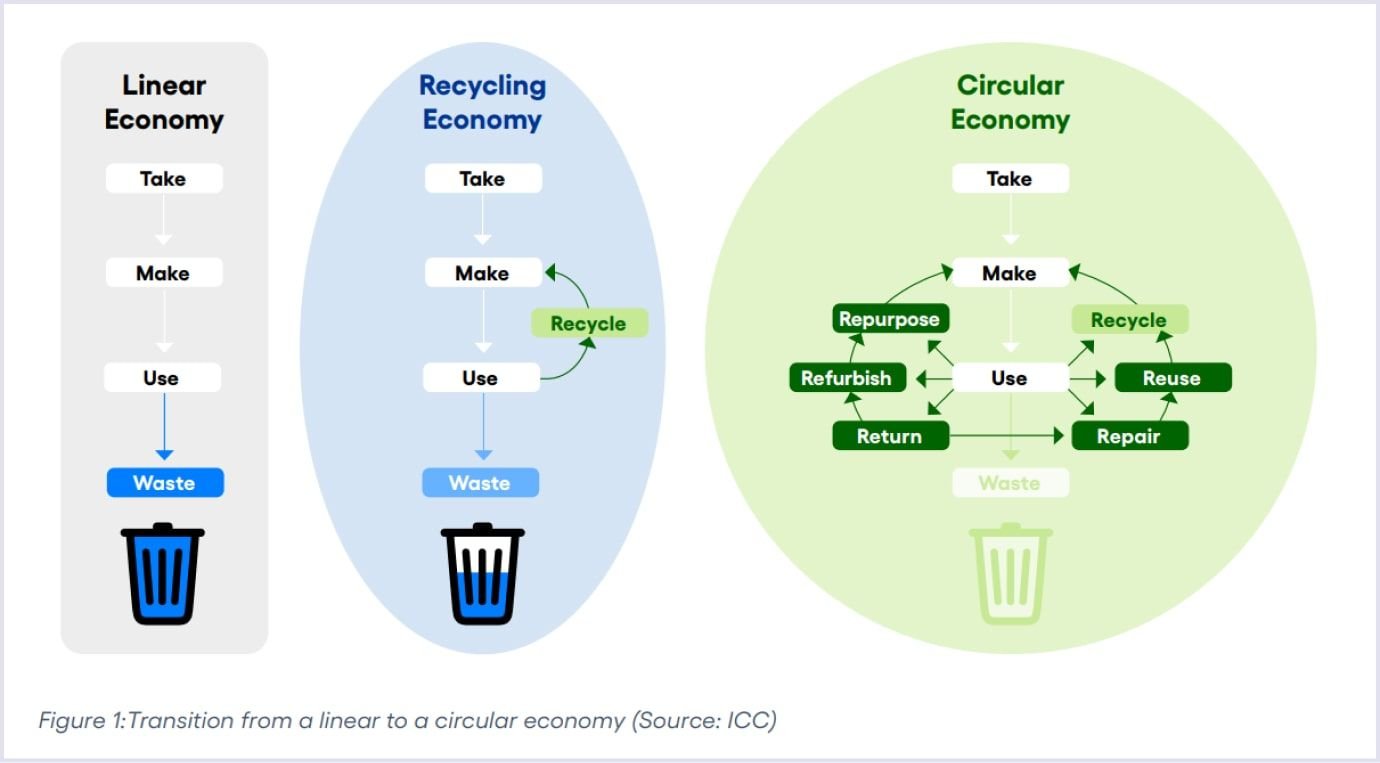
Source: International Chamber of Commerce (ICC) report 2024
AI-optimized platforms
Artificial intelligence has become an indispensable part of digital solutions and ecommerce platforms in particular. Its capabilities in personalization and optimizing operations give tangible results to ecommerce businesses. By optimizing workflow with AI, an online marketplace minimizes resource consumption and unnecessary replenishments and provides better customer service.
Streamlining deliveries with blockchain
When people encounter the term “Blockchain,” it is mainly associated with cryptocurrencies. Meanwhile, the technology is widely used in different industries to trace products and optimize delivery processes. Thanks to reliable encryption, blockchain helps trace even large and complex supply chains. Thus, it makes your delivery processes fast and reduces resource consumption.
For example, Walmart can trace food origins within 2.2 seconds with blockchain. The company also uses it for handling payments between Walmart and its multitude of carriers.
Wrapping up
An online marketplace for eco-friendly products combines business and environmental sustainability in ecommerce. Sustainability is in growing demand, and stats show that more customers will switch to eco-friendly products and shipping if such alternatives exist in the marketplace.
We have been building successful marketplaces for over 9 years, and you can read about them in our portfolio. If you have a project in mind that aims to spread sustainable products, we would be happy to help you build it. Contact us, and our experts will provide you with the necessary guidance and best practices in development.
